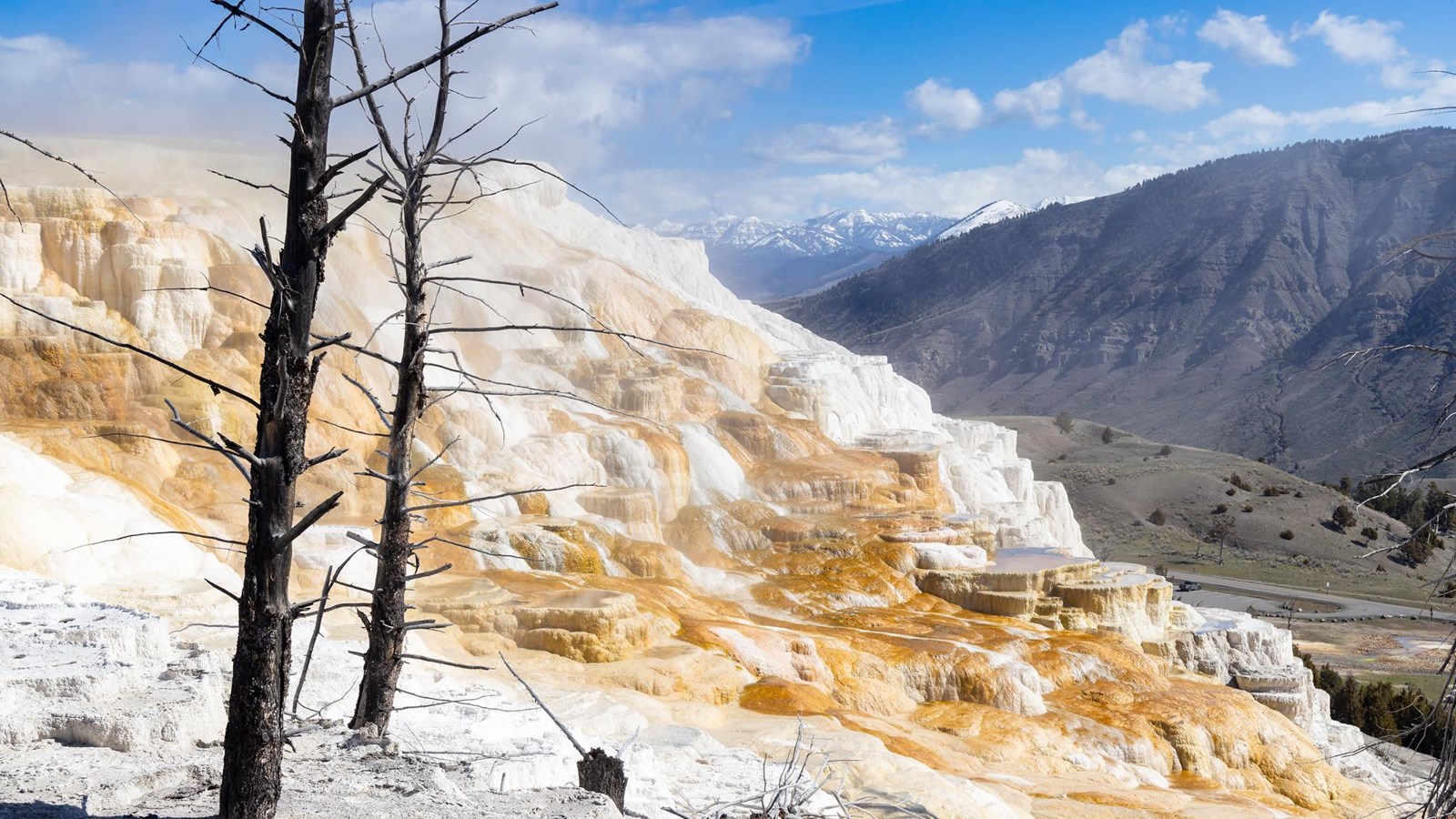Last updated: December 3, 2024
Place
Upper Terrace Trailhead

NPS / Jacob W. Frank
Historical/Interpretive Information/Exhibits, Information Kiosk/Bulletin Board, Trailhead, Wheelchair Accessible
This trailhead leads out to the top of Mammoth Hot Springs, with close-up views of Dryad Spring, Canary Spring, Grassy Spring, and Cupid Spring along boardwalks. The boardwalks near Cupid Spring begin descending down through the Mammoth Hot Springs terraces, connecting to the Lower Terraces.
Mammoth Hot Springs
A network of fractures and fissures form the plumbing system that allows hot water from underground to reach the surface at Mammoth Hot Springs. Small earthquakes may keep the plumbing open. The water comes from rain and snow falling on surrounding mountains and seeping deep into the earth where it is heated.
The volcanic heat source for Mammoth Hot Springs remains somewhat of a mystery. Scientists have proposed two sources: the large magma chamber underlying the Yellowstone Caldera or a smaller heat source closer to Mammoth.
For hundreds of years, Shoshone and Bannock people collected minerals from the Mammoth Hot Springs terraces for white paint.
Travertine Terraces
Travertine terraces are formed from limestone (calcium carbonate). Water rises through the limestone, carrying high amounts of dissolved calcium carbonate. At the surface, carbon dioxide is released and calcium carbonate is deposited, forming travertine, the chalky white rock of the terraces. Due to the rapid rate of deposition, these features constantly and quickly change.
Accessibility
Transitions from asphalt walkways to boardwalks may require assistance. Some sections of boardwalk are wheelchair-accessible. The rest of the area has stairs or steep grades due to terrain. Distance from parking in front of Liberty Cap to the end of the boardwalk at Palette Spring is approximately 135 yards.
Use Caution in Hydrothermal Areas
- Stay on boardwalks and designated trails.
- Hydrothermal water can severely burn you.
- Never run, push, or shove.
- Supervise children at all times.
- Do not scratch hydrothermal mats.
You are responsible for your safety.
Think safety, act safely. Yellowstone is a dangerous place.
Upper Terrace Loop Ski and Snowshoe Trail
The Upper Terrace Loop Ski Trail is a groomed 1.5-mile (2.4-km) loop that ranges from easy to more difficult due to a steep downhill section if traveled to the right (counter-clockwise) from the trailhead.
This loop begins at the Upper Terrace parking area. It is easiest if skied beginning to the left (clockwise). A moderate climb leads to views of hot springs, terraces, the Mammoth Hot Springs Historic District, and the surrounding mountains. At the top of the climb, a trail veers off to the southwest, which connects with the Snow Pass Trail. The Terrace Loop Trail descends past more hot springs before completing the circuit. Since snow depths here are less than in the mountains above, wintering elk and deer are occasionally sighted.
Notes:
- Bison and elk frequent this trail. Federal regulations require you to stay at least 100 yards (91 m) away from bears and wolves, and at least 25 yards (23 m) away from bison and all other wild animals.
- There are thermal areas along this trail and some areas do not hold snow. Stay on boardwalks and designated ski trails. The ground is unstable in hydrothermal areas.
